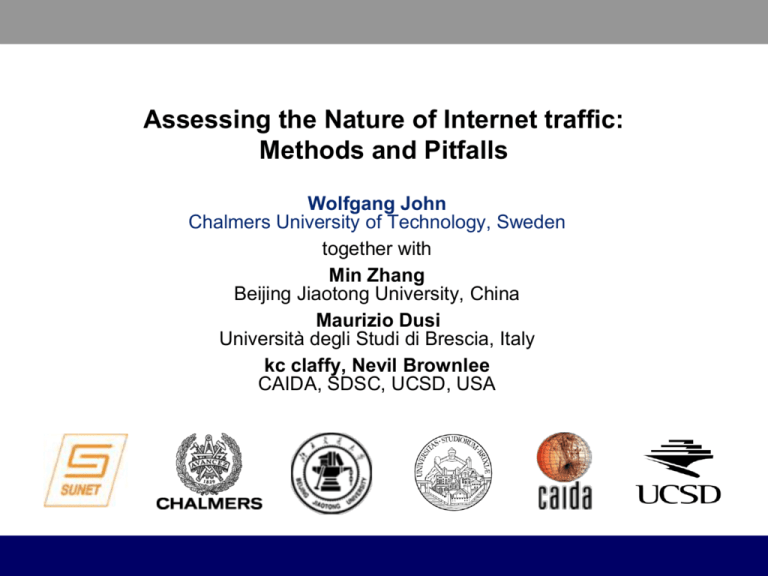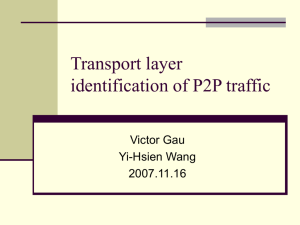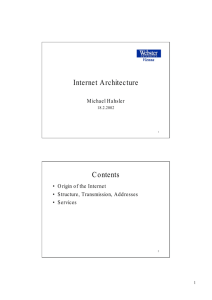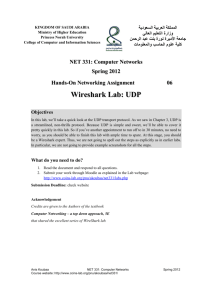MonNet A project for network and traffic monitoring
advertisement

Assessing the Nature of Internet traffic: Methods and Pitfalls Wolfgang John Chalmers University of Technology, Sweden together with Min Zhang Beijing Jiaotong University, China Maurizio Dusi Università degli Studi di Brescia, Italy kc claffy, Nevil Brownlee CAIDA, SDSC, UCSD, USA Introduction • Traffic classification (TC) ? ? ? ? Bittorrent ? ? HTTP ? SMTP TrefPunkt 20 2009-05-13 Introduction (cont.) • Why traffic classification? – – – – – – Network design and provisioning QoS assignment and traffic shaping Accounting Security monitoring: IDS/IPS Network Forensics Trends and changes in network applications TrefPunkt 20 2009-05-13 Outline • Classification Methods – Research review and taxonomy • Survey analysis: P2P • Pitfalls – Systematic shortcomings – Re-validate assumptions • UDP rising • Routing (a)symmetry on backbone links TrefPunkt 20 2009-05-13 Research Review and Taxonomy • Research review – create a structured taxonomy of traffic classification papers and their datasets – help to answer popular questions – reveal open issues and challenges http://www.caida.org/research/traffic-analysis/classification-overview TrefPunkt 20 2009-05-13 Research review and taxonomy: Overview • 64 papers published between 1994 and 2008 • Definition: traffic classification “Methods to classify traffic data sets based on features passively observed in the traffic, according to specific classification goals.” TrefPunkt 20 2009-05-13 Research review and taxonomy: Datasets and Goals • Data sets: >80 data sets used for 64 papers! – Time of collection, link type, capture environments, geographic location, (payload, anonymization), etc. • Classification goals: – Coarse or fine-grained classification – Applications or protocols TrefPunkt 20 2009-05-13 Research review and taxonomy: Features • Features – Reacting on application development TrefPunkt 20 2009-05-13 Research review and taxonomy: Methods • Methods – exact matching • port number, payload, etc – heuristic methods • e.g. on connection patterns – machine learning methods • supervised and unsupervised TrefPunkt 20 2009-05-13 Survey analysis: P2P • How much P2P? 1.3% to 93% across the 18 (out of 64) papers TrefPunkt 20 2009-05-13 Survey analysis: P2P (contd.) • So how much of modern Internet traffic is P2P? "there is a wide range of P2P traffic on Internet links; see your specific link of interest and classification technique you trust for more details." TrefPunkt 20 2009-05-13 Survey analysis: P2P (contd.) • SUNET: April till Nov. 2006 TrefPunkt 20 2009-05-13 Outline • Methods – Research review and taxonomy • Survey analysis: P2P • Pitfalls – Systematic shortcomings – Re-validate assumtions • UDP rising • Routing (a)symmetry on backbone links TrefPunkt 20 2009-05-13 Systematic Shortcomings • Poor comparability of results!!! – 80 data sets by 64 papers → lack of shared, modern data sets as reference data – no clear definitions (P2P or file-sharing …) → lack of standardized measures → lack of defined classification goals TrefPunkt 20 2009-05-13 Assumption: TCP dominates traffic • Current TC approaches consider mainly TCP – Assumptions • TCP is dominating traffic • Bulk (data) transfer is done via TCP – Advantage • TCP has a clear notion of “sessions” TrefPunkt 20 2009-05-13 Assumption: TCP dominates traffic (cont.) • There might be a shift (soon): – IPTV applications • PPLive, PPStream: switched to UDP in Oct. 2008 • VA (Video Accelerator): UDP for data transfer – P2P applications • uTP: Micro Transport protocol, based on UDP – Part of uTorrent 1.9 beta, expected during 2010 All on high, random ports (of course …) TrefPunkt 20 2009-05-13 Assumption: TCP dominates traffic (cont.) TrefPunkt 20 2009-05-13 Assumption: TCP dominates traffic (cont.) • CDF of UDP flows per Port number Indeed, high ephemeral ports are common today! TrefPunkt 20 2009-05-13 Assumption: TCP dominates traffic (cont.) • Avg. Packets/Flow for top 10 UDP ports No substantial data portions carried (on these links - yet) TrefPunkt 20 2009-05-13 Assumption: TCP dominates traffic (cont.) • Current situation (on the links measured) – TCP dominating pkts (bytes), UDP dominating flows • UDP for P2P overlay signaling • This might change soon: – UDP based IPTV already common in China, uTP … • UDP for bulk and streaming data transfer → TC methods can no longer ignore UDP? TrefPunkt 20 2009-05-13 Assumption: routing symmetry • Current approaches consider bidirectional traffic – Assumption • Traffic is routed symmetrically – Same path for forward and backward direction – Advantage • Bi-directional information offers more features for classification • For TCP, bi-directional information allows easier inference of sessions (connections) TrefPunkt 20 2009-05-13 Assumption: routing symmetry (cont.) • Degree of symmetry – 4 link locations (Sweden and USA) – 2 samples each TrefPunkt 20 2009-05-13 Assumption: routing symmetry (cont.) • Beyond Intranets and access links (edge networks), there is little symmetry • Degree of symmetry decreases with level of “coreness” of the link → TC methods for backbone links need to master unidirectional data flows TrefPunkt 20 2009-05-13 Summary • Research review – structured taxonomy of traffic classification papers • Current systematic shortcomings → lack of shared, modern data sets as reference data → lack of standardized measures → lack of defined classification goals • Upcoming technical challenges → TC methods can no longer ignore UDP → TC methods should handle unidirectional flows TrefPunkt 20 2009-05-13 Traffic classification overview: http://www.caida.org/research/traffic-analysis/classification-overview/ Observations on UDP traffic on Internet backbone links: soon to be published on www.caida.org (“News” section) Estimation of routing asymmetry on Internet links: http://www.caida.org/research/traffic-analysis/asymmetry/ or Email: johnwolf@chalmers.se





